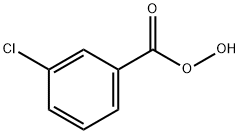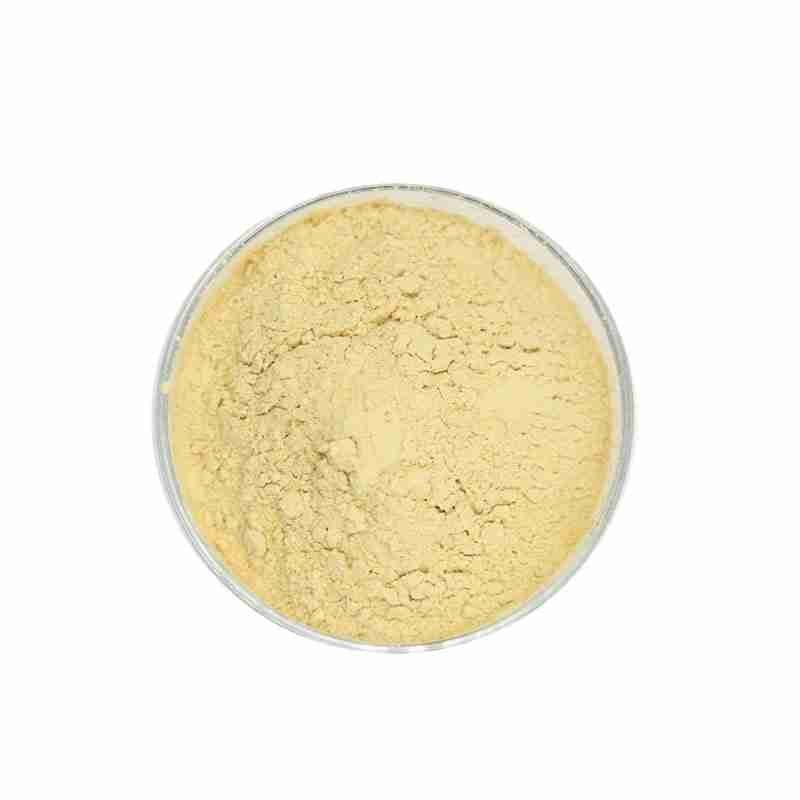3-Chloroperoxybenzoic Acid CAS# 937-14-4
3-Chloroperoxybenzoic acid (m-CPBA) is a carboxylic acid derivative, a white powder crystal, almost insoluble in water, conveniently soluble in ethanol, ether, soluble in chloroform, dichloroethane. Steady to warm, the annual disintegration price is listed below 1% at room temperature level. Disintegration rate is accelerated in liquid state.
In a polyethylene container, include 1.5 g of magnesium sulfate heptahydrate, 36g of sodium hydroxide, 360ml of water, 90ml of 30% hydrogen peroxide, 450ml of dioxane as well as ice cubes, reduced the temperature level to 15 ?? C, as well as include 52.5 g of M-chlorobenzoyl chloride, after that include ice to keep the temperature level listed below 25 ?? C. After reacting for 15 mins, include 900ml of 20% chilly sulfuric acid. After standing still, the organic layer was divided, filteringed system, and the filtrate was evaporated to eliminate the solvent (high vacuum cleaner distillation) to get 51g of 3-chloroperbenzoic acid.
发送询盘
3-Chloroperoxybenzoic Acid CAS# 937-14-4
| 3-Chloroperoxybenzoic acid Basic information |
| Chemical Properties?Uses |
| Product Name: | 3-Chloroperoxybenzoic acid |
| Synonyms: | 3-CHLOROPEROXYBENZOIC ACID;3-Chloroperoxy benzoic acid(more than 57% but not more than 86%,with 3-chorobenzoic acid);3-Chloroperoxybenzoic acid, balance 3-Chlorobenzoic acid and water, 70-75%;3-Chloroperoxybenzoic acid, 70 – 75%, (balance 3-chlorobenzoic acid and water);3-Chlorobenzeneperoxycarboxylic acid;3-Chloroperoxybenzoic Acid (contains min. 17% Water and min. 6% 3-Chlorobenzoic Acid);3-Chloroperoxybenzoic Acid (contains ca. 30% Water);3-Chloroperoxybenzoic acid ,75% |
| CAS: | 937-14-4 |
| MF: | C7H5ClO3 |
| MW: | 172.57 |
| EINECS: | 213-322-3 |
| Product Categories: | Organic Peroxide;Oxidation;Synthetic Organic Chemistry;Organic acids;PHARMACEUTICAL INTERMEDIATES;Aromatics;bc0001;top |
| Mol File: | 937-14-4.mol |
 |
|
| 3-Chloroperoxybenzoic acid Chemical Properties |
| Melting point | 69-71???C(lit.) |
| Boiling point | 244.67??C (rough estimate) |
| density | 0.56 |
| vapor pressure | 0.373Pa at 25?? |
| refractive index | 1.4580 (estimate) |
| storage temp. | 2-8??C |
| solubility | Chloroform (Slightly), Ethyl Acetate (Slightly), Methanol (Slightly) |
| pka | 7.57 (in water @ 25 ??C) |
| form | Moist Powder |
| color | White |
| PH | 4.5@25 ??C (saturated aq. sol) |
| Odor | slight pungent odor |
| Water Solubility | insoluble |
| Decomposition | >88 ??C |
| BRN | 608317 |
| Stability: | Strong oxidizing agent – contact with combustible material may cause fire. May be shock or heat sensitive. Incompatible with organic materials, strong reducing agents. |
| InChIKey | NHQDETIJWKXCTC-UHFFFAOYSA-N |
| LogP | 1.03 at 25?? |
| CAS DataBase Reference | 937-14-4(CAS DataBase Reference) |
| NIST Chemistry Reference | 3-Chloroperbenzoic acid(937-14-4) |
| EPA Substance Registry System | Benzenecarboperoxoic acid, 3-chloro- (937-14-4) |
- 2
- 2-diallylpent-4-en-1-amine
- 4
- 95-16-9
- Ammonium sulfamate
- Benzothiazole
- cas:67889-00-3ح2
- cas:83524-75-8 | pigment black 32
- cas:928836-00-4 | 2
- cas:932745-70-5 | 4
- Chemical Minerals
- Coconut diethanolamide
- Daily Chemicals
- discount
- for sale
- General pvc resin
- hexyl D-glucoside
- in stock
- Lauramidopropyl betaine
- LAURIC ACID MONOETHANOLAMIDE
- Petroleum Additives
- Plasticiser
- Ploymers
- price
- PVC
- quotation
- Raw Materal
- Remove term: Petroleum Additives Petroleum Additive
- SODIUM ETHYL 2-SULFOLAURATE
Related Products
Benzothiazoles are a class of chemical compounds characterized by a fused benzene and thiazole ring. They exhibit a broad spectrum of applications, particularly as antioxidants in rubber and plastic industries, enhancing product longevity and performance. Additionally, benzothiazoles serve as key intermediates in the synthesis of pharmaceuticals, contributing to the development of life-saving drugs. Recognized for their stability and reactivity, these compounds are integral to advancing material science and healthcare solutions.
3,4-Ethylenedioxythiophene is a synthetic organic compound characterized by its unique structure that includes a thiophene ring with ethylenedioxy substituents at the 3 and 4 positions. This compound is known for its potential applications in the synthesis of various organic materials, including pharmaceuticals and organic electronic devices such as sensors and solar cells. Its stability and reactivity make it a versatile intermediate in the chemical industry.
Octyl 4-methoxycinnamate, scientifically known as 2-Ethylhexyl 4-Methoxycinnamate, is a highly effective organic UV filter commonly used in the formulation of sunscreens and cosmetic products. This compound is renowned for its ability to absorb ultraviolet B (UVB) radiation, providing a reliable defense against the sun’s harmful effects on the skin.
Characterized by its chemical formula C19H28O3, Octyl 4-methoxycinnamate is a liquid ester that is readily soluble in organic solvents. It is valued for its photostability, which means it maintains its protective properties even after prolonged exposure to sunlight. This feature makes it an ideal ingredient for products designed to offer long-lasting sun protection.
In addition to its UVB absorption capabilities, Octyl 4-methoxycinnamate is also appreciated for its compatibility with other UV filters, allowing for the creation of broad-spectrum sunscreens. It contributes to the development of formulations that are non-greasy and cosmetically elegant, suitable for a variety of skin types.
As a key component in sun care products, Octyl 4-methoxycinnamate supports the skin’s health by preventing sunburn, reducing the risk of skin cancer, and delaying the signs of photoaging. Its safety profile and efficacy make it a preferred choice in the personal care and dermatological industries for sun protection solutions.
Chemical Name: Choline salicylate
CAS No.: 2016-36-6
Molecular Formula: C12H19NO4
Molecular Weight: 241.28
Appearance: Red-Brown Crystal
Chemical Name: 3-Hydroxybutyric acid
CAS No.: 625-71-8
Molecular Formula: C4H8O3
Molecular Weight: 104.1
Appearance: White powder
N,N-Dimethylaniline is an organic compound with amine and methyl groups attached to a benzene ring. It is a colorless liquid with a characteristic amine odor. This compound is primarily used as a chemical intermediate in the synthesis of dyes, pigments, and polymers. Its reactivity makes it a valuable building block in the production of various organic compounds, particularly in the pharmaceutical and chemical industries.
Tetraacetylethylenediamine is a fully acetylated derivative of ethylenediamine, offering a high reactivity as an intermediate in organic synthesis. Its unique structure makes it a critical component in the production of specialty chemicals and pharmaceuticals, ensuring a wide range of applications in the chemical industry.
Product name:HYDROXYPROPYL GUAR HYDROXYPROPYLTRIMONIUM CHLORIDE
Purity:99%
Appearance:Light Yellow Powder
Package:Customized according to customer needs.
Sample:Available
Terpene resin is a type of natural resin derived from terpenes, which are organic compounds found in various plants. It is known for its aromatic properties and is commonly used in the production of fragrances, flavorings, and as a component in adhesives and coatings within the chemical industry. Terpene resin offers a range of benefits, including enhancing the solubility of essential oils and providing a stable base for various applications. Its natural origin makes it a preferred choice for eco-friendly products.
Polyhexamethylene guanidine hydrochloride, often abbreviated as PHMG-HCl, is a high molecular weight polymeric biguanide compound known for its potent antimicrobial properties. With a chemical structure that features a long chain of methylene groups bridged by guanidine units, PHMG-HCl is effective against a broad spectrum of microorganisms, including bacteria, viruses, and fungi.
This hydrochloride salt form of PHMG is highly soluble in water and is commonly used in various applications due to its non-irritant and non-toxic nature to human skin and mucous membranes. It is widely recognized for its ability to form a colorless and odorless solution, making it an ideal choice for use in personal care products, medical disinfectants, and water treatment processes.
The versatility of PHMG-HCl lies in its cationic nature, which allows it to bind to negatively charged microbial cell walls, disrupting their integrity and leading to cell death. This mechanism of action contributes to its effectiveness as a preservative and disinfectant. Moreover, its substantivity, or the ability to adhere to surfaces, enhances its long-lasting antimicrobial activity.
In summary, Polyhexamethylene guanidine hydrochloride is a reliable and efficient antimicrobial agent, pivotal in industries where hygiene and cleanliness are paramount, offering a safe and sustainable solution for microbial control.
1-Octanol, also known as Capryl alcohol or n-Octanol, is a clear, colorless liquid with a characteristic waxy odor. It is an alcohol with eight carbon atoms in its chain, making it a part of the aliphatic alcohol family. This compound is poorly soluble in water but is miscible with ethanol, diethyl ether, and chloroform . It has a melting point of approximately -15??C and a boiling point of around 196??C . 1-Octanol is used in the production of esters, plasticizers, and as a solvent or intermediate in the synthesis of various organic compounds. It also finds application in the fragrance industry as a fixative in perfumes and can be used in the formulation of flavor and scent compositions . It is important to note that 1-Octanol is flammable and should be handled with care, storing it away from sources of ignition and heat .
Chemical Name: 1,1,2,2-Tetrachloroethane
Other Name: Tetrachlorethane
CAS No.: 79-34-5
Molecular Formula: C2H2Cl4
Molecular Weight: 167.85
Appearance: Liquid


















